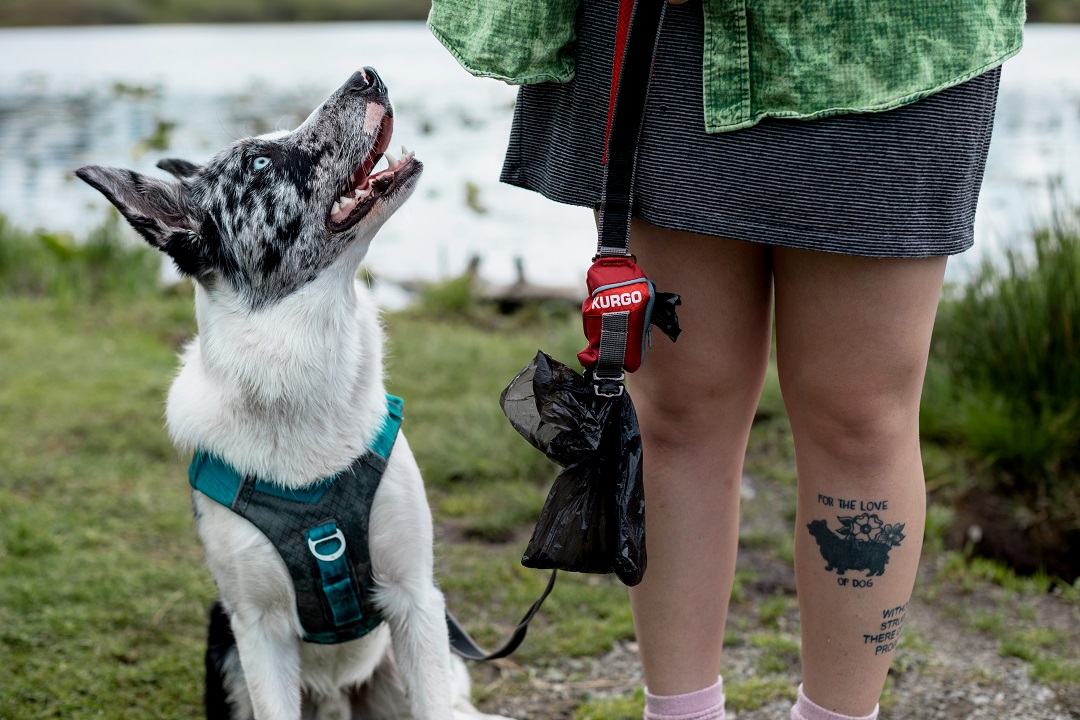- Expert tips and tricks for running with a dog
- How to keep your dog safe nd healthy while running
We’re willing to bet that you’re not the only member of the family who needs to burn off calories and energy. We speak from experience.
A lapsed runner, I returned because of Spud, a Labrador retriever mix shelter dog who initially focused his abundant energy on chewing our carpet. Rather than return him for unruly behavior, I laced my old shoes, grabbed his leash, and off we went. Those 2 miles dissipated his frantic energy, and the ritual soon became the highlight of his (and my) day. His exuberance was infectious, and he became my reason to brave the cruddiest of weather and attitudes to jog together.
We became a perfect pair, much like Finn and Dr. RuthAnn Lobos, marathoner and lead veterinarian at Nestle Purina. “He LOVES to run and follows me around like a shadow, as if I could forget to bring him with me,” she said of her Lab.
Spud and I fell ass backwards into an aligned set of variables for successful dog running that Lobos knows well. As does Helen Dixon, co-founder of Trail & Kale, a website devoted to trail running and the outdoors, who enjoys working out with Kepler, her border collie.
Here are their (and our) tips for making your dog the ideal running mate.
Breed: German shorthaired pointers, Labs, vizslas, collies, dalmatians, and golden retrievers are good choices to go the distance. On the other hand, snub-nosed breeds like pug, bulldog, shih tzu, and Lhasa apso struggle to breathe during exertion. Likewise, greyhounds, salukis, and whippets, known for speed, are unsuited for runs of more than a mile or so.
Age: Spud was about 15 months old when we took our first run, which is about right. But just as you wouldn’t start a personal exercise plan without a checkup from your physician, dogs should have their vet sign off.

Dr. RuthAnn Lobos and Finn.
“Puppies’ bones, muscles, and coordination skills are still developing; therefore, keeping the sessions short on more forgiving surfaces like dirt, grass, and trails will help protect their growing bodies,” Lobos said. “After they reach skeletal maturity, the runs can gradually get longer on sidewalks and asphalt.”
Use a leash or harness: Keeping your dog under control makes running easier and safer. A harness can be a good option, since it’s easier on the dog’s neck and gives the human more control.
Dixon noted, though, that steep and gnarly terrain better lends itself to a handheld leash attached to Kepler’s collar, but added, “If we encounter a trail with an obstacle such as a river or drop-off, we switch to his harness, so he’s connected to us by his body rather than his neck, in case one of us were to slip over.”
Temperature: Dogs don’t sweat; they pant. Their cooling mechanism isn’t designed for hot summer runs, so the American Kennel Club conservatively recommends running between 15 and 60 degrees Fahrenheit. Lobos added: “Asphalt and sidewalks in the summer can become hot enough to burn their pads, and ice in the winter can be slippery even for our four-leggeds.”
We ran at sunrise in the summer, inspired by the light of the golden hour. In the winter, Spud’s double coat kept him warm until the wind chill plummeted into negative digits, but we avoided treated roads; the choppy ice and salt can inflict a world of hurt that your pal will never let you know about.
Food: Lobos recommends avoiding meals and snacks for a couple hours on either side of a run to allow for absorbing the nutrients from their food and avoid upset tummies.
Water: Bring it and stop frequently, every 20 minutes or so. Or find a source, such as a park fountain, and use the nifty Collaps A Bowl from Kurgo. We often ran a 2-mile loop, so I’d stash a bottle on the hood of my car. I’d grab it at the start of our second lap, help myself, then give him a turn.
Bathroom breaks: We’d take care of business in the backyard or on a short walk before a run. But never forget the poop bag. Dixon swears by Kurgo’s Duty Bag.
Check and double-check: Dogs mask pain and fatigue but have a few tells. Dixon knows to call it a day with Kepler when his breathing is heavier, his eyes start to look tired, and he’s less keen to pull ahead and starts to run alongside her.

The author and Spud.
And Lobos suggests a post-run once-over. “We once came back from a 15-mile run, and he was still raring to go,” she said. “As I was stretching my tired legs, I lifted his front paw and found he had two sticker burs in his pad that had clearly been there for a good portion of the run, but he never even limped! He was too focused and having fun to notice.”
Spud loved to run so much that he and I chose to ignore for too long that he could barely trot beyond the end of the block and that we had to walk slowly back up the hill to make it home.
To leave him behind broke my heart.
Years have passed, but at some point on every run I hear the tick-tick-tick of his paws and tags, serving as my metronome. I look down, then miss him, but honor his companionship by continuing to slog along. The gift he gave me has stretched far beyond his days, and I hope will last my lifetime.
Author: Kathleen Nelson is a regular contributor to Terrain Magazine.


Leave A Comment